Weather radios are an important part of early warning systems for weather emergencies like tornadoes, severe thunderstorms, and flash floods. The NOAA Weather Radio is a nationwide radio network that continuously broadcasts weather information and updates straight from the offices of the National Weather Station (NWS) located all over the country.
While ordinary AM/FM radios can function during weather emergencies, dedicated weather radio scanners are equipped with features that are particularly useful in such situations, like longer ranges, NOAA alerts, and alarm systems.
The best NOAA weather radios also have Specific Area Message Encoding (S.A.M.E.) technology to make sure you receive alerts that are specific to your location, as well as alternative power sources that can be used when the power is out.
With the many models available today, we’ve put together a list of the best weather alert radios currently in the market and a quick buying guide to help you narrow down your choices.
Best Weather Radios
| # | PREVIEW | Product | |
|---|---|---|---|
| 1 |
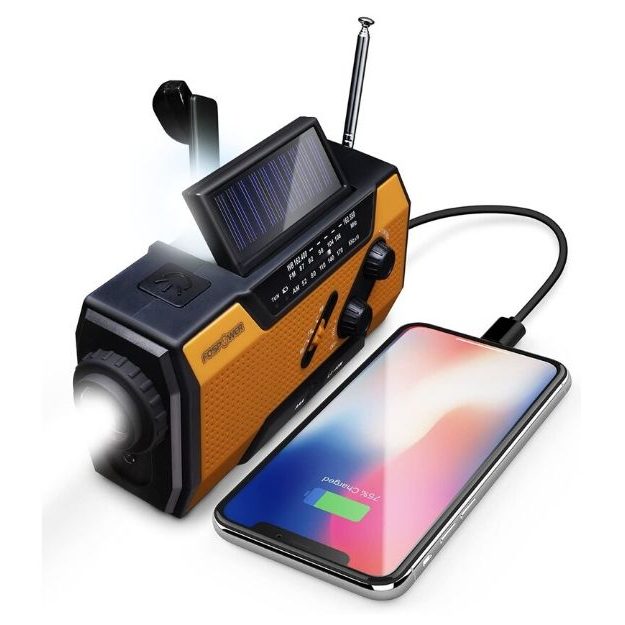
|
|
|
|
|
|||
| 2
Best For Low Budgets
2Vondior NOAA Weather Radio
|
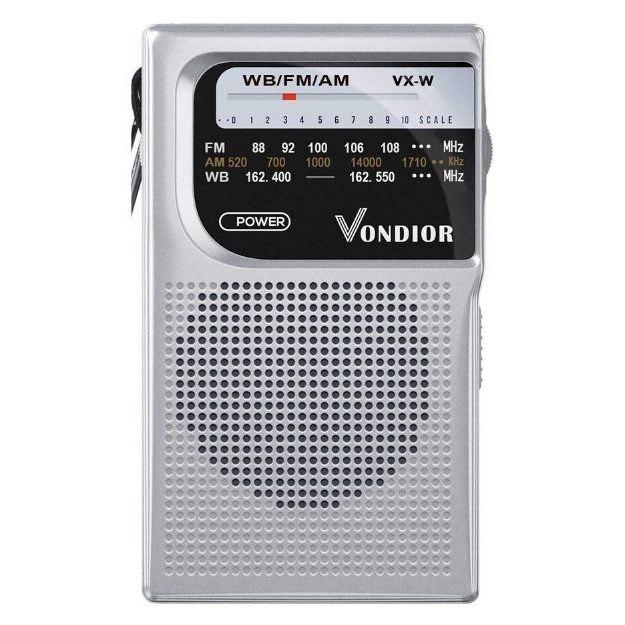
|
|
|
|
|
|||
| 3
Best For Higher Budgets
3Midland WR400 Deluxe Weather Radio
|
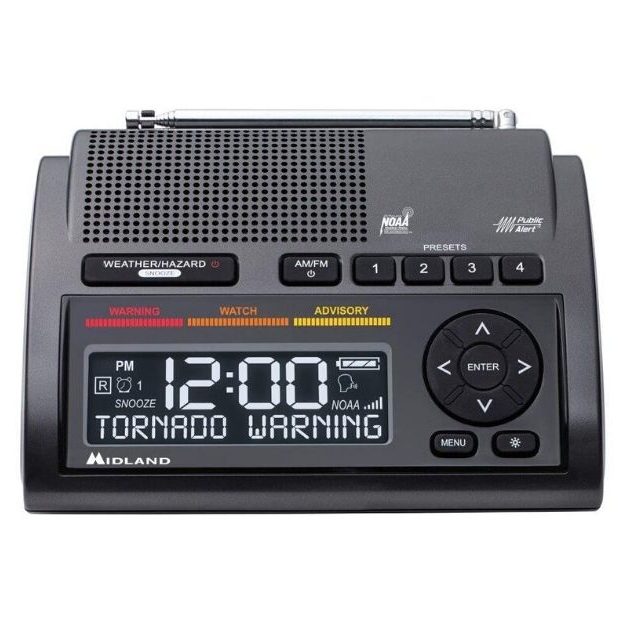
|
|
|
|
|
|||
| 4
Best Overall
4Outtdoor Weather Crank Radio
|
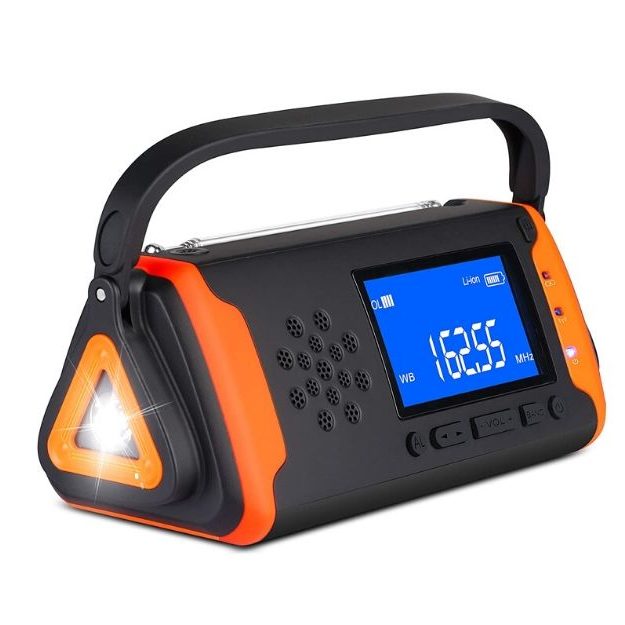
|
|
|
|
|
|||
| 5 |
![iRonsnow - IS-088+ [1000mAh] Solar Hand Crank Radio 5 iRonsnow - IS-088+ [1000mAh] Solar Hand Crank Radio](https://theradiojudge.com/wp-content/uploads/2020/07/iRonsnow-IS-088-1000mAh-Solar-Hand-Crank-Radio-625x625.jpg)
|
|
|
|
|
|||
1. FosPower Emergency Weather Radio
- 3 power sources
- IPX3 water resistance
- 2000-mAh power bank
- Limited lifetime warranty
Measuring only 6.20” x 2.90” x 2.10”, FosPower’s ultra-portable emergency radio comes with a 2000-mAh power bank for charging smartphones and other mobile devices. It has three power sources: a crank lever, solar panel, and AAA batteries.
It can access all AM and FM networks, along with NOAA channels, so you can stay up-to-date with the latest forecasts. Moreover, it has four LED reading lights and a 1W LED flashlight with zoom.
In life-threatening situations, you can activate its SOS mode, which turns on a loud siren and a red warning light. The radio is drop-proof and water-resistant. It has an IPX3 rating, which means a little rain won’t stop it from receiving weather forecasts and updates.
Specifications
Pros
- Rechargeable power
- Reading lights and a flashlight
- 3 power sources
- NOAA weather broadcast access
Cons
- Batteries not included
- Lacks headphone jack
2. Vondior NOAA Weather Radio
- Cutting-edge DSP chip
- High-quality speaker
- 6-inch antenna
- Pocket-sized
With its portable design, the Vondior NOAA Weather Radio is a useful gadget that you can easily keep in your emergency bag or take with you wherever you go.
It’s powered by 2 AA batteries and is built to run on them for days so can stay updated even when the power’s out. It can receive any of the 7 weather channels (WX) for timely alerts on any severe weather emergencies.
This handheld weather radio doubles as an AM/FM transistor radio, so you can also use it to listen to music or other news programs. Thanks to its DSP chip and 6-inch antenna, it’s able to receive broadcasts from anywhere in the US.
Specifications
Pros
- Easy to operate
- Clear marks for weather, AM, FM bands
- Reliable reception even in secluded areas
- Classic design
Cons
- Relies on batteries to operate
- Lacks alert function
3. Midland WR400 Deluxe Weather Radio
- S.A.M.E. Digital Technology
- Color-coded alert level indicators
- Powerful 85 dB alarm
- 25 programmable locations
Recommended by the Department of Homeland Security for Emergency Preparedness, the Midland WR400 is a first alert weather radio that supports all 7 NOAA and Canada weather band channels.
It features voice alerts, an 85 dB siren alarm, and a tri-color alert level program for a more effective early warning system against weather and civil emergencies. The combination of its S.A.M.E. technology and its programmable location feature enables warnings specific to your designated area.
This model also features an AM/FM radio, an alarm clock, and a USB port for charging your devices during emergencies. Alphanumeric warning messages can be viewed on its blue backlit LCD display. It features over 80 alert messages and can store up to 10 previous alerts.
Specifications
Pros
- Backlit LCD display
- Alarm clock with snooze option
- Alert override
- USB charging port
Cons
- Volume of the initial alert can’t be changed
- Not waterproof, meant mainly for desktop use
4. Outtdoor Weather Crank Radio
- Weather alert function
- Loud SOS alarm, lights blink in Morse code
- 4 charging options
- Aux music play
The Outtdoor Weather Crank Radio is a multi-function equipment with 4 ways for charging. As an emergency radio, you can connect to any of 7 NOAA frequencies and receive real-time weather updates.
It features a public alert system that can help you avoid missing important information during emergencies. It also has a powerful SOS alarm that enables you to let rescuers know where you are.
You can use it to listen to AM/FM stations and, with its AUX music player, even to the tunes on your phone. It can function as a bright 1W LED flashlight and a 4,000mAh power bank. This radio offers 4 power charging options: solar, USB, hand crank, and 3 AAA batteries.
Specifications
Pros
- Informative LCD screen display
- Portable handheld design
- Clear audio quality
- Accurate digital tuner
Cons
- May encounter some static while tuning in AM
- Does not use S.A.M.E. technology
5. iRonsnow IS-088+ Weather Radio
- Lightweight and compact
- Dynamo LED flashlight
- 1,000mAh Power bank
- Clever design to prevent accidental dial turn
Besides being an AM/FM weather radio, the iRonsnow IS-088+ also functions as a power bank for charging mobile phones and other small gadgets.
It also incorporates an LED 1W/50 lumens flashlight in its design. These features make this model an all-around emergency equipment. Its compact and lightweight build makes it easy to carry around. As a NOAA/WB weather radio, it boasts good reception, so you’ll be able to easily access weather news in your area.
There are 3 ways to charge its built-in battery: solar, hand crank, and USB. This gives you more flexibility in powering up your radio, which is helpful in emergency situations where you’re not sure what available resources you can use to charge your device.
Specifications
Pros
- Good battery retention
- Sensitive tuner
- Strong, solid casing
- Universal compatibility with any device
Cons
- Requires mini USB cable for charging
- Turning knobs may be stiff to some
Weather Radio Buying Guide
Top Brands
Most all-weather radios offer the basic functionality of receiving any of the 7 NOAA weather band channels, but only the top brands can offer additional features that are especially helpful during emergencies.
These features may range from powerful alert systems, utilization of S.A.M.E. technology, and multi-functionality. Some of the best weather radios come from brands like Midland, Eton, Acurite and Radio Shack.
Midland
Midland is one of the renowned brands when it comes to radio equipment. Established in 1959, Midland Radio Corporation has been developing premium-quality radio products, starting from two-way radios and now expanding to weather radios.
With more than 50 years of experience, the company is considered an industry leader in radio communications technology. Thus, it comes as no surprise that the Midland weather radio is recommended by the Department of Homeland Security for Emergency Preparedness.
Midland offers a range of NOAA weather radios that have topnotch reliability for effective early warning during emergencies. These radios are fairly easy to set up and they feature an alert system that uses S.A.M.E. technology, allowing you to stay informed about relevant weather updates in your locality.
Eton
Eton is another weather radio brand that’s been popular since 1986. It focuses on creating products that help keep people safe and informed. The first hand crank emergency radio is one of their innovations.
Their products range from backup battery packs and solar-powered sound systems to weather alert radios. It has established such a strong name in the category that the American Red Cross has partnered with the company.
Eton weather radios are known for their versatility, durability, reliability, and convenience. Most models offer multiple ways of charging, usually solar and hand crank, to ensure your radio works even during prolonged power outages. The radios also double as flashlights and power banks, which can be very helpful during emergencies.
Acurite
Acurite is one of the top brands in North America when it comes to weather products. The company’s offerings are favorites at major retailers nationwide. Acurite weather radios, in particular, are known for their precision, reliability, and ease of use.
Through the S.A.M.E. technology, these devices are able to deliver accurate weather information that’s tailored specifically to your location.
They also feature a powerful siren sound alarm to help you avoid missing important warnings. Most models come with a bright LCD display that shows relevant information like warning type and alert messages.
Radio Shack
As a company that specializes in electronics, Radio Shack has consistently produced quality products, such as headphones, batteries, parts and accessories, and AM/FM weather radios.
Radio Shack weather radios offer excellent reception for weather band channels while still being easy to set up, use, and tune. They all have a compact design, so you can conveniently place them on tabletops without taking too much space.
NOAA Weather Radio Frequencies
NOAA Weather Radio is the most comprehensive network for weather and emergency information, relaying updates about all types of hazards in 90% of the 50 states. There are 7 NOAA Weather Radio frequencies in the VHF Public Service band that any weather radio sold today can access.
These frequencies are: 162.400 MHz, 162.425 MHz, 162.450 MHz, 162.475 MHz, 162.500 MHz, 162.525 MHz, and 162.550 MHz. Older models of weather radio receivers have limited frequencies, usually covering only 162.400, 162.475 and 162.550, but any model sold today is able to pick up a station on any of the 7 frequencies listed above.
NOAA Weather Radio Codes
There are 80 NOAA Weather Radio Codes available that are generally classified into 3 types: advisory, warning, and watch. These codes are usually composed of 3 letters, although question marks are sometimes incorporated to indicate unrecognized elements. These codes cover anything from weather emergencies and evacuation watch to food and chemical contamination and child abduction alerts.
Type
One of the important factors to look into when choosing a weather radio is its power source. Weather radios are mainly used during emergencies, and in these situations, it might be difficult to find a stable power source, so it’s important to consider the alternative ways through which your radio can be charged. Nowadays, you can find radios that can be powered in various through solar charging, through hand crank, and through battery operation.
Crank Weather Radio
Crank weather radios are powered by turning the hand crank attached to the unit. They may seem outdated, but they’re actually very useful in situations where you don’t have access to usual power sources like electrical outlets, batteries, or even sunlight.
You can power the radio just by yourself, which makes this type very convenient in emergencies.
Battery Operated Weather Radio
Battery-operated weather radios, on the other hand, need batteries for power. These radios can have a rechargeable built-in lithium-ion battery or require batteries separate from the unit, or both. With the rechargeable internal battery, you can charge the radio via an AC outlet or by using a USB cable when you have access to electricity.
Separate AA or AAA batteries, meanwhile, are common household items.
Applications
Weather radios can be classified based on their applications. Besides being considered emergency radios, they’re also used in maritime voyages and in outdoor camping trips. Generally, they serve the same purpose: keeping you updated on weather and emergency situations.
Marine
Marine weather radios are attuned towards coastal marine forecasts and updates, as produced by the local offices of the NOAA Weather Radio All Hazards (NRW) network. The information provided includes tide predictions and real-time observations made by the coastal meteorological stations and buoys. While most marine VHF radios can receive NWR broadcasts, it’s still recommended to have a separate marine weather radio so you can keep a simultaneous watch on both.
Camping
While tabletop radios can be good for home use, a weather radio that’s light and portable is recommended for camping trips. Since, unless you bring a portable generator, you would most likely not have access to a stable electrical source in the great outdoors, it’s best to go for a weather radio that has alternative ways of being powered. It would also be helpful to get a radio that offers multi-functionality, such as devices that function an LED flashlight and a power bank.
Frequently Asked Questions

Before programming your Midland weather radio, you must first put in the required number of batteries into the compartment on the underside of the unit and plug the radio’s AC adapter into an outlet. Turn on the unit and follow the steps below once it enters setup mode:
- Press Enter to set up the language, then use the Up or Down buttons to select your desired language.
- Set the location and choose among the options: Any, Multiple, and Single. Once you’ve selected your preferred option, press Enter.
- If Any has been selected, the next step would be to input the time.
- If Multiple or Single has been selected, input your specific location: your country, state, and county. For the Single option, you’ll be directed to input the time. For the Multiple option, repeat the same process until you fill the list, or choose the Nearby option to automatically populate your list with nearby counties.
- Set the time by selecting the hour and the minutes.
- The next step is setting up the channel. Pull out the antenna and extend it to its full length, then press Enter. Using the Up and Down buttons, scroll to your preferred channel, which you can double-check by visiting the NOAA site for station listing. Select your channel and press Enter.
- After setting your language, location, time, and channel, your settings are now saved. Your radio is ready to use and can now receive weather alerts. Just press the Weather/Hazard button to listen to the weather radio.

For those who are shopping online, we recommend purchasing your weather radio on Amazon for safe and secure transactions of genuine items as well as hassle-free delivery to your doorstep.
If you’re making the purchase in-person and want to go to a physical store, you can check shops that sell electronics or you may contact the local NWS office nearest you for recommendations.

There are 7 radio frequencies that NOAA Weather Radio stations use to broadcast, and these are: 162.400 MHz, 162.425 MHz, 162.450 MHz, 162.475 MHz, 162.500 MHz, 162.525 MHz, and 162.550 MHz.
Our Verdict
When choosing the best weather radio for yourself, it’s important to take note of the main purpose it will serve. Will it for home use or for camping trips? Keeping this in mind can help you narrow down choices.
For example, tabletop units do well indoors but may not be so convenient when you’re outside and mobile.
All weather radios sold today offer good reception of the 7 NOAA weather band channels for weather bulletins, but some offer added features and functionality, which you may not need if your main concern is just to be informed. LED flashlights and power banks are more useful for those who are out camping.
Another aspect that you have to consider is the power source for your weather radio. Most models nowadays offer alternatives to AC outlet charging, such as batteries and charging via solar and hand crank.
With all these in mind, we hope that our list of top picks and our buying guide help you choose the best weather radio.

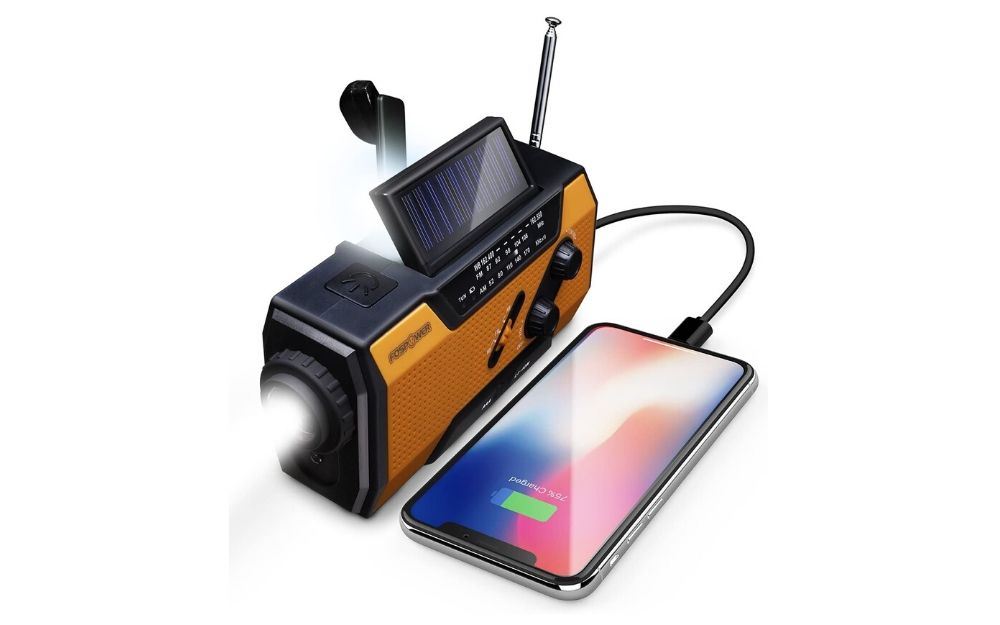
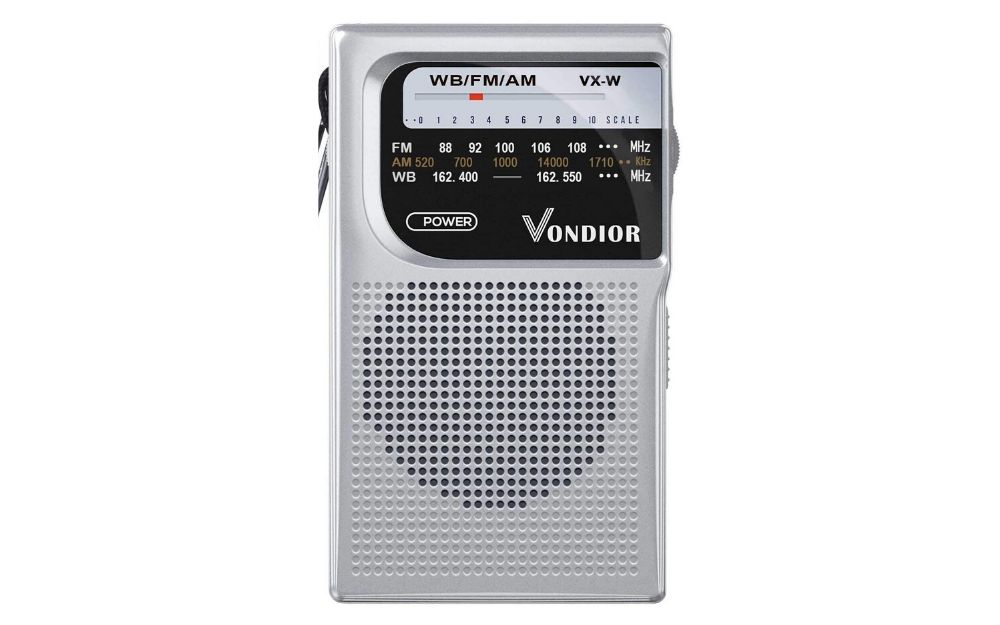
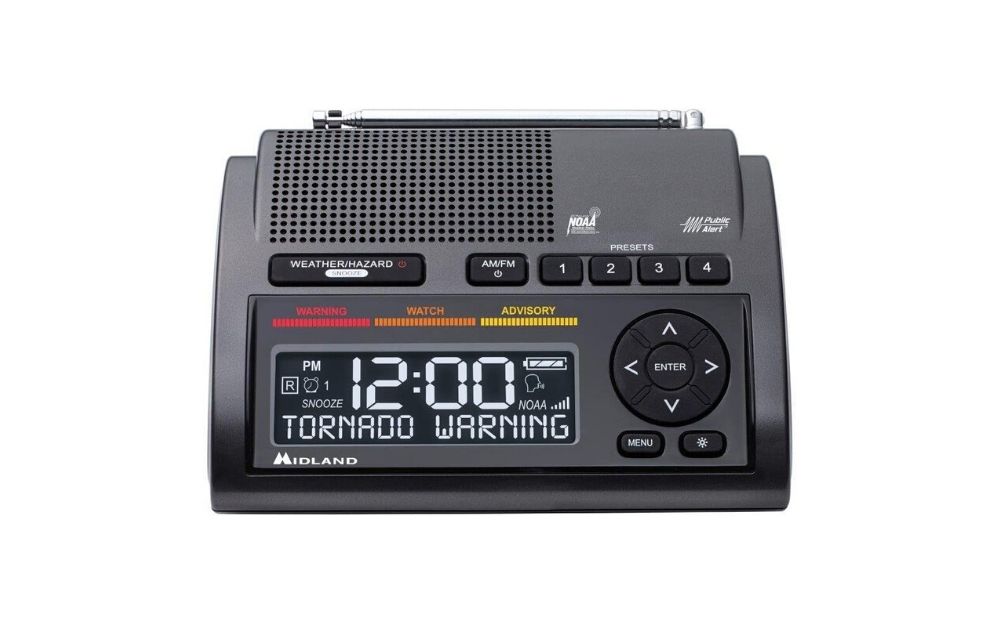
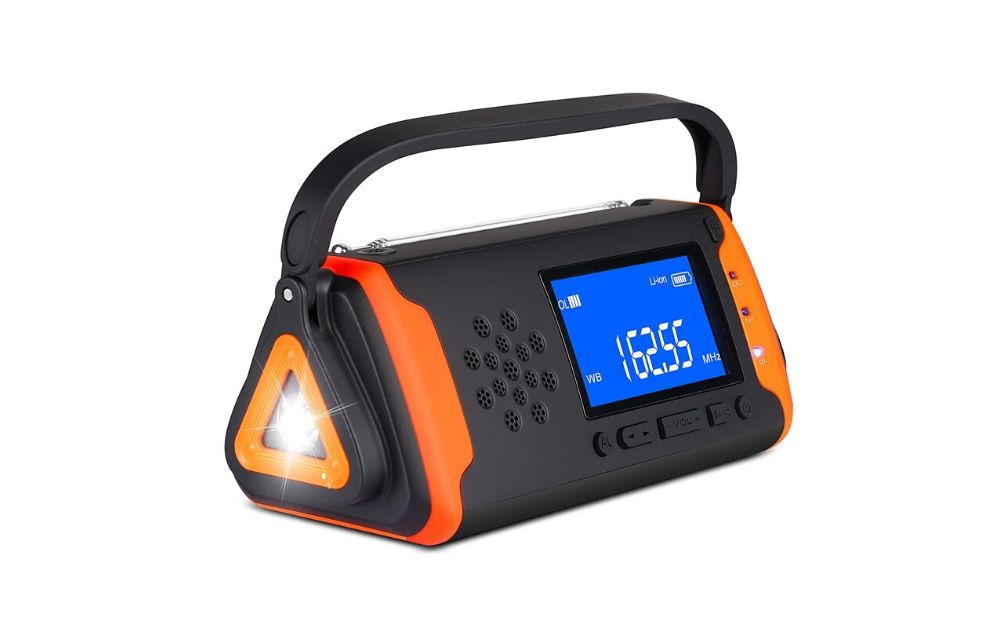
![iRonsnow - IS-088+ [1000mAh] Solar Hand Crank Radio 10 iRonsnow - IS-088+ [1000mAh] Solar Hand Crank Radio](https://theradiojudge.com/wp-content/uploads/2020/07/iRonsnow-IS-088-1000mAh-Solar-Hand-Crank-Radio.jpg)
